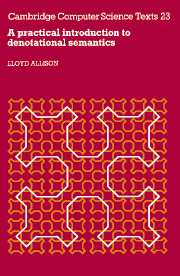Book contents
Summary
Denotational semantics is a formal method for defining the semantics of programming languages. It is of interest to the language designer, compiler writer and programmer. These individuals have different criteria for judging such a method – it should be concise, unambiguous, open to mathematical analysis, mechanically checkable, executable and readable depending on your point of view. Denotational semantics cannot be all things to all people but it is one attempt to satisfy these various aims. It is a formal method because it is based on well-understood mathematical foundations and uses a rigorously defined notation or meta-language.
The complete definition of a programming language is divided into syntax, semantics and sometimes also pragmatics. Syntax defines the structure of legal sentences in the language. Semantics gives the meaning of these sentences. Pragmatics covers the use of an implementation of a language and will not be mentioned further.
In the case of syntax, context-free grammars expressed in Backus–Naur form (BNF) or in syntax diagrams have been of great benefit to computer scientists since Backus and Naur [44] formally specified the syntax of Algol-60. Now all programming languages have their syntax given in this way. The result has been ‘cleaner’ syntax, improved parsing methods, parser-generators and better language manuals. As yet no semantic formalism has achieved such popularity and the semantics of a new language is almost invariably given in natural language.
The typical problem facing a programmer is to write a program which will transform data satisfying some properties or assertions ‘P’ into results satisfying ‘Q’.
- Type
- Chapter
- Information
- Publisher: Cambridge University PressPrint publication year: 1987



